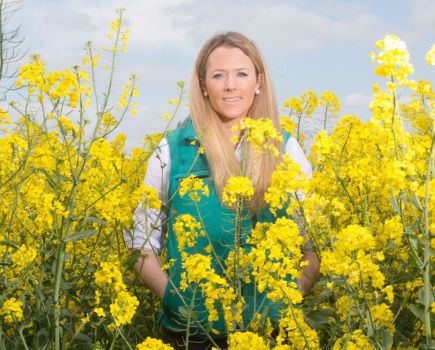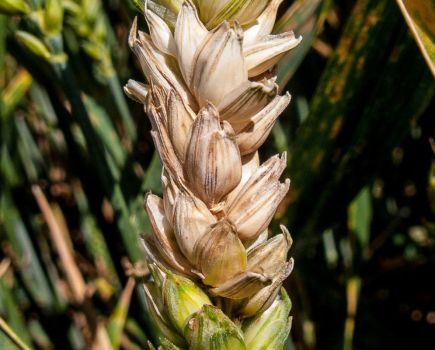After years of decline in planted area, something is shaking up Group 3 and that something is Bamford – a new soft wheat variety with yields contending with the top performers plus numerous end market opportunities. CPM takes a deep dive into the variety.
“It’s become clear that Group 3 has become tired and requires rejuvenating.”
By Melanie Jenkins
It’s been some time since a Group 3 has been added to AHDB’s Recommended List and turned heads, but with the admission of Elsoms Seeds’ Bamford to the 2024/25 RL, that could be about to change.
Group 3 wheats have gone through a few tough years, having largely been sidelined for Group 2s and soft and hard Group 4s, which have offered vastly more yield potential and solid disease scores, says Frontier’s Jim Knightbraid.
NIAB data on seed sales for the current and past four seasons shows that Group 3s have fallen from accounting for 10.81% of the market for Harvest 2020, to a projected 1.6% for Harvest 2024. In contrast, Group 2 market share has risen from 10.7% to an estimated 19.7%, and hard Group 4s now account for a predicted 52.2%, up from 43.6%, in the same time period.
“We’ve seen such a stark decline in sales of Group 3 seed that the market has essentially stagnated,” acknowledges Jim. “It’s become clear that Group 3 has become tired and requires rejuvenating – the sector almost hasn’t been serving itself. With the elevation of Bamford to the RL it looks like this decline could be arrested.”
NIAB’s Patrick Stephenson, who chairs the RL wheat committee, has watched Bamford’s progress through variety testing since NL 1. “There are always potential traps such as disease, which can collapse a new variety, but Bamford came through trials with remarkable consistency. As soon as Bamford was assigned as a Group 3 variety, it stood out from the crowd. It’s good to see it join a Group with a poorer disease background as it now brings a strong package as well as yield and market opportunities to a depleted area of the RL.”
It was Bamford’s potential marketability that first drew Jim’s attention. “Even more so than its yield and agronomics – right from the National List trial stage it stood out. Bamford has wide marketing options, it’s ticking a lot of boxes and has closed the gap to the highest yielding feed wheats.”
Hutchinsons’ David Bouch firmly agrees: “Bamford is worthy of everyone’s attention. It’s high yielding (106%) along with the best on the RL such as Beowulf and Champion, but the big difference is that it’s a soft variety. And, more importantly, it’s a soft Group 3 and not a Group 4. Although Group 3s have fallen out of fashion, Bamford is offering a desirable combination of high yield, grain quality and premium end markets that should appeal to growers. Most varieties will offer one of these three qualities; Bamford offers them all, so it’s pretty much a no-brainer to grow it.”
And its premium market potential is geographically widespread, says David Bouch. “Around the home counties it could be sold as a biscuit wheat, if you’re in the South East, there’s opportunity for export and if you’re in Yorkshire and above, Bamford could be used for distilling – the variety ticks so many boxes.”
Patrick agrees that although the traditional Group 3 growing area was north of Yorkshire into Durham, Northumberland and Scotland, which Bamford suits because of its suitability to distilling, the variety has a far more extensive appeal. “It’s performed over a wide range of soil types and has been consistent, and consistency is key to a variety having longevity on the market. Lots of growers have stuck with varieties such as Gleam or KWS Barrel because of their consistency, and Bamford looks like it’ll offer this same trait, alongside its other qualities.”
Frontier has already had positive conversations with several millers and will be offering a specific Bamford grain contract for Harvest 2025. “We’re always looking to link growers with end markets and to provide marketing options that encourage them to benefit from new seed genetics,” says Jim.
According to Dalton Seeds’ David Huish, although Bamford is a true Group 3 variety, it’s important to not pigeonhole it as just a premium wheat. “The variety’s yield potential means it’s worth growing, whether for a quality end market or for feed, either way it should deliver a big crop at the end of the season.”
Ironically, Bamford’s highest yield is in the West (107%), says David Bouch. “This is obviously the least dependent on biscuit, export and distilling markets, but it’ll still suit growers who are just aiming to fill the barn.”
Agronomically, he feels the variety doesn’t have any weaknesses. “Bamford has a Hagberg of 239, and a specific weight of 78.5kg/hl. With such a high specific weight, the risk is minimal – it’d have to be a really bad year for it to drop below 72kg/hl and not all varieties are so secure.
“In theory, it should take over from all other biscuit wheat varieties as it supersedes anything else in Group 3, and outperforms the soft Group 4 biscuit varieties in terms of quality – it might even take out some hard Group 4s because of its yield. If there’s enough seed available, it should walk onto the market without resistance this year and take an 8-9% share.”
One aspect of Bamford that Jim finds particularly interesting is the variety’s genetic parentage. “Genetic diversity isn’t always something at the fore of variety selection but it’s important to consider,” he says. “Many Group 3 varieties share Cougar in their parentage, and this is something which caught people out when there was a breakdown to septoria a few years ago.
“Bamford doesn’t have Cougar as a parent, which is unusual for a Group 3 soft wheat. Instead it’s a cross between Moulton and an internal line from Elsoms, EW129, which aren’t varieties currently being used in the UK market. This provides growers an opportunity to bring genetic diversity onto farm and therefore resilience if we do see a breakdown in resistance.”
Patrick is also keen to see new genetics brought to the table. “The hope is that because of its parentage, Bamford’s septoria resistance (6.7) will remain resilient. We obviously didn’t expect to see the issues with Cougar become quite so extensive, but so many varieties relied on its septoria resistance genes that when the breakdown occurred it was vast. Although Bamford brings new genetics into the breeding line, it’ll be important to spread risks on farm, especially if the variety becomes a roaring success because the pressure on its genetic resistance will increase.”
Bamford scores a 7 against yellow rust on the RL, which David Bouch believes is particularly important for the Eastern counties. “It should lend itself to a lot of growers without them having any fear that there’ll be issues with the variety. It looks to be a robust performer agronomically at this point in time.”
David Huish feels that Bamford offers growers a strong option as a second wheat as it has the Pch1 eyespot resistance gene. “We’ve not really seen a weakness with the variety, which makes it really interesting and a good choice in the second wheat slot.”
But according to David Bouch, Bamford’s shortfall is that it doesn’t have Orange Wheat Blossom Midge resistance. “This is an issue only one season every eight or nine years, and although we haven’t seen the disease for a while, there’s nothing else that you should be concerned about.”
In areas where OWBM is an issue, Patrick advises growers to keep the variety’s lack of resistance in mind. “It can be a bit of an Achille’s heel in the South, but we can also go years without an issue at all.”
When exploring which varieties to multiply for seed, Jim explains that Frontier starts by looking at out-and-out yield, but over the past few seasons the firm has started to focus on other features. “Two of these characteristics which are particularly valuable in Bamford are its potential drilling window and its growth habit – both how it performs after drilling in the autumn and then in the spring.
“We’ve seen growers shift to a much wider range of drilling dates since the wet autumn of 2019. This experimenting has revealed that many varieties have capabilities beyond what we’d previously thought,” explains Jim. “The focus has predominantly been on earlier drilling, following years of late drilling to manage blackgrass, so we want to be able to provide advice on which varieties are suited to this earlier slot. We see Bamford as a good option here because of its autumn growth habit and straw strength (7 with a PGR and without).”
David Bouch is curious to see how the variety’s standing performance plays out as the season progresses. “Nothing will have a particularly deep root structure this year, so if we have a long, dry spell, it’ll be interesting to see if Bamford can manage testing conditions.”
Jim points out that it’s important to have varieties in the market that can cope with a range of different systems. “There are a lot of different establishment methods, and some varieties might perform better than others, but ideally, we’re looking for varieties that can cope in a range of different systems. In direct drilled situations, autumn vigour is important but probably not as much as how a variety grows when it comes out of the blocks in the spring. Preferably, varieties will fill out the rows as fast as possible which also helps with grassweed competition, and based on our experience with Bamford, it does this.
“Although there are other varieties suited to this early window, Bamford brings this in combination with yield, so you have this option without a trade-off or compromise,” he adds.
For growers operating regenerative systems or who might be concerned with spray timings, David Huish highlights that Bamford could be a good option in these situations. “It’s really important to note its untreated yield (92%) as this is really strong, helping to give growers reassurance.”
David Bouch promoted Bamford heavily in Hutchinson’s trials last year because he was so confident in the variety. “I told growers that it would walk onto the list and although they wouldn’t be able to secure seed for this year’s harvest, they could get ahead and secure it for next year. Growers are already ordering it in sizeable volumes, so there’s significant demand for it.”
As both a new variety and with seed multiplication taking as much of a hit from the difficult season as commercial crops, Jim feels that Bamford is likely to sell out soon. “We’ve seen significant early interest, and this is certainly a year where you’ll want to be proactive, plan your rotation and put your seed order in promptly.”
Patrick highlights that quite often new varieties are viewed with an element of caution by growers. “We see growers err on the side of caution and not always want to change to new varieties quickly, but in Bamford’s case, I think the seed stocks will be snapped up quickly.”
This article was taken from the latest issue of CPM. Read the article in full here.
For more articles like this, subscribe here.
Sign up for Crop Production Magazine’s FREE e-newsletter here.




